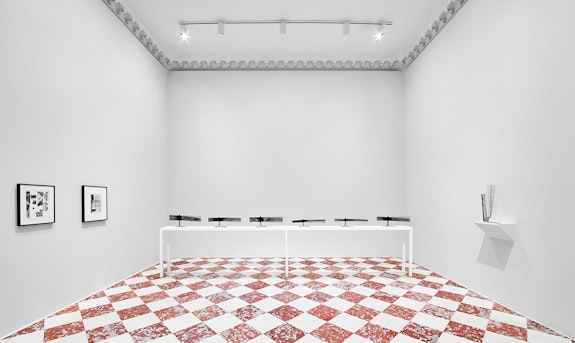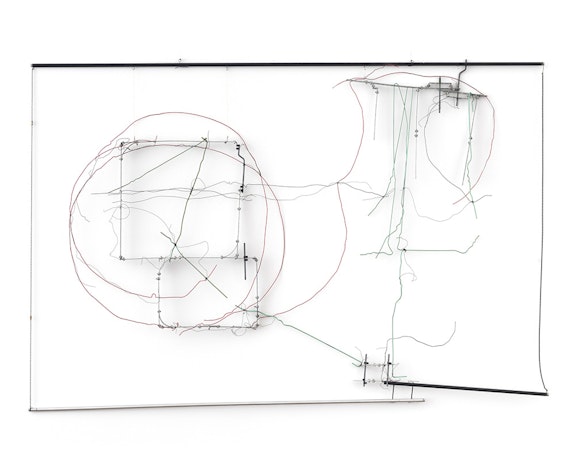ArtSeen
Gego: Lines in Space

On View
LGDR GalleryLines in Space
June 7–July 7, 2023
New York
It takes a subtle hand to map the invisible, to be attuned to whispers, and barely realized thoughts. It takes a particular softness to orchestrate a rest in the din with enough force to open us with its lightness. Gego is a master of narrating the unseen. In liking with her style, LGDR’s new gallery on 64th Street includes a small but potent show with her works from 1961–1990. The artworks are instruments, vibrating with silence in the form of steel and bronze sculptures, line drawings, watercolors, and weavings.
Gego was born Gertrud Louise Goldschmidt, a daughter of Jewish bankers in 1912 in Hamburg. By 1939 she was forced to flee the Nazi occupation, settling in Caracas when she was twenty-six. In Venezuela, Gego worked as an engineer and architect for nearly twenty years before coming into her art practice in earnest at the age of forty-one. At this turning point her work morphed quickly. Watercolor landscapes of deep green and red, became shadows traced on walls, or large interconnected structures. She always worked with lines to activate her work: the true root of her practice. Informed by architectural practice, her creations are living buildings with apparent structural simplicity and dizzying repetition, an effect which yields a subtle but unmistakable force.

Gego’s aptitude is how she implicates the viewer through repetition and the invitation to move in relation to the work. Works like Sin título (1968) are reminiscent of ripples in the water, existing in variations of transparency and momentum. Her ink and crayon drawings operate like optical illusions, creating visual jumps and starts, a response that requires the witnessing of the artwork for it to truly manifest. Often ascribed to the kinetic movement in the 1950s, which included artists such as George Rickey, Jesús Rafael Soto, and Carlos Cruz-Diez, Gego, uniquely, produced works by hand, an element which lends to their spontaneity. So the rippling lines in Sin título quiver with life. Within each line—whether wire or ink—the handmade quality brings forth the intention of the action. Gego once described the line as a thought. A hand drawn line has a language all on its own. Within the frail border an intention is written, both against the lines next to it, and with the quality of the marking itself.
Upon first glance Gego’s work is static, but our eyes are helplessly drawn to movement. There is a Bernini statue of the pursuit of Daphne by Apollo at the Borghese Gallery in Rome. Bernini invites the viewer to walk around the statue in order for it to tell the story of Daphne becoming a laurel tree. On one side she is a nymph and the other, all at once, a tree. Gego uses this technique to create transformation in static objects, embedding a wriggle in the clutter, but with less grandeur. Gego gives careful homage even to the tiniest life. The steel Sin título (1970), reminiscent of rigid horse hair, transforms before the eye in surprising flits, through a dance of movement produced by the circumambulation of the viewer.
Meccano (1985) is almost a perfect frame, yet it hangs by the small beaded lines used to turn on lights. Wires and parts that look like they should be attached to a lightbulb create a rounded and rectangular shape. Together these two forms cast a shadow on the wall behind them. The scraps of material and the shadow bring to mind a lightbulb. What Meccano does not show is a light, but it succeeds in manifesting a light from the interplay of shadow and memory. Indeed, perhaps we are the lights. Gego produces a machine, here, which implicates the viewer in its existence.

In Gego’s quest to animate the matrix, she explored the weft and whey. One of Gego’s first mediums was that of the book, using paper, string, and line to formulate the concept of story. LGDR has included several of her wovens such as Tejedura 90/8 (1990), which are made of found paper. Gego does not disrupt the line here, nor the framework, but the pattern, not unlike the recently popularized 0’s and 1’s of the computer, the found paper rises up and down out of solid white lines, implicating a reinterpreted story from their original purpose and a new understanding of how they can be used.
The natural environment is prevalent throughout Gego’s work. Chorro (1979/86) which translates to ‘stream’, was a series Gego worked on for many years and one of her most popular forms, received generously by the public in her lifetime. Chorro has a subtle form made of wire points constellating around an absence. It is unclear whether the structure is going up or down, but there is a movement to it, like the silverback of water. Chorro reminds us that the world is held together on the thinnest threads of connection. We are merely walking through a webbed emptiness, and if we were to turn our heads toward openings we may realize how profoundly full of space we are.

